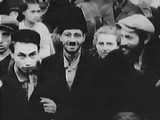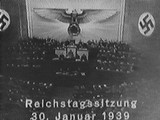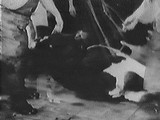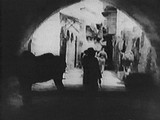 |
 |
The Role of "Produced Reality" in the Decision-Making Process Which Led to the Holocaust
Oral presentation of paper given at the conference "Genocide and the Modern World," Association of Genocide Scholars, Concordia University, Montreal, Canada, June 11-13, 1997
Stig Hornshøj-Møller, Copenhagen, Denmark
Ladies and Gentlemen,
Please allow me first of all to express my gratitude to the Conference Committee for giving me a special session at this conference. To present more than 25 years of research within twenty minutes is an almost impossible task - especially as I may have arrived at some rather controversial conclusions.
However, I do hope to be able to clarify some of my main arguments for a new interpretation of the decision-making process which led to the Holocaust.
You will know from the summary, that I have used two different approaches: A source-critical/semiotic one - and a psychological one. Due to the limited amount of time I will concentrate on the first one, because it contains my key methodological argument: The importance of visual perception in the decision-making process.
That means that I would like to raise and discuss the highly complex question of the integration of non-written evidence into inter-disciplinary research, and I will try to argue why I consider the Nazi propaganda film "Der ewige Jude" to be an X-ray of the Holocaust decision-making process itself.
Film historians have always interpreted this film as a deliberate call for the Holocaust. To quote Erwin Leiser, it should "turn brave citizens into willing mass-murderers." Such an evaluation is, however, seemingly encumbered with one big problem - chronology. "Der ewige Jude" was produced in 1940, whereas most historians today regard 1941
 |
When I started my research in 1970, I intended to show that Leiser's conclusions were based on hindsight. I wanted to demonstrate that a proper source-critical analysis of the film, its production and distribution history would demonstrate a total lack of evidence in support of this claim.
However, I was proved utterly wrong. I have only found evidence that supported the notion of the film as a deliberate call for genocide.
The sources for the production history of "Der ewige Jude" reveal that the final version was a joint product by Adolf Hitler and Joseph Goebbels.
The "Führer" followed the production of the film very closely, gave ideas and ordered several recuts. The main responsibility for the film, however, definitely lies with Joseph Goebbels.
After having approved a news-reel with a major issue on Polish Jewry on October 4, 1939, Goebbels initiated the production of a propaganda film, which should look like reality. The very next day, he outlined the concept to two prominent members of his staff.
The script was developed by Dr. Eberhard Taubert, Head of anti-bolshevik and anti-semitic activities, while Dr. Fritz Hippler, Head of the Film Department, was sent to Poland to film Orthodox Jewry in the ghetto of Lodz.
In the evening of October 16, 1939, Hippler presented about 30 minutes of rushes, showing alleged Jewish ritual slaughter of cows, calves and sheeps to Goebbels. Although Goebbels himself had ordered these recordings to be cruelty to animals, he was nevertheless deeply shocked at what he saw.
He wrote in his diary the next morning:
Scenes so horrific and brutal in their explicitness that one's blood runs cold. One shudders at such barbarism. This Jewry must be annihilated.
Goebbels showed these rushes to Hitler and others present at Hitler's dinner table on October 28, 1939. According to his diary they were all "deeply shocked." And in estimating the effect on Hitler one should not forget his attitude towards animals: he was a lover of animals and almost religiously vegetarian.
To Adolf Hitler these scenes - and later the whole film, in which they were used as the emotional climax - can only have reinforced his paranoid anti-Semitism and his latent wish to exterminate the Jews.
On October 31, 1939, Goebbels personally went to Lodz to see for himself. He summarized his impressions in his diary:
They are no longer human beings, but animals. It is, therefore, also no humanitarian task, but a task for the surgeon. One has got to cut here and that most radically. Or Europe will vanish one day due to the Jewish disease.
According to his diary, Goebbels was explicitly confirmed in this opinion by Hitler, when he reported on his visit to Poland on November 2, 1939:
Above all my description of the Jewish problem finds his (i.e. Hitler's) total approval. The Jew is garbage. Rather a clinical than a social matter.
It certainly became the task of "Der ewige Jude" to "prove" this exterministic view upon Jewry to all those Germans who did not as yet share these sentiments.
During the following weeks and months entries in Goebbels' diary document how intensely he worked on this film, and how important both he and Hitler considered it to be. Thus, in his diary on November 19, 1939:
I inform the Führer about our Jew film. He gives some ideas for it. On the whole, film is a very valuable propaganda medium for us just now.
It should be noted that both Goebbels and Hitler regarded themselves as experts on film propaganda. On December 11, 1939, the "Führer"
 |
The first cut of January 8, 1940, contained only "Jewish" scenes (including a vivid juxtaposition of Jews and swarms of rats). It climaxed with the explicit bloody slaughter scenes.
Hitler, however, turned this version down on January 11, 1940.
In the subsequent versions a re-cut quotation of Hitler's notorious speech of January 30, 1939 was added. It was presented as the Führer's own, public "prophecy" of the future fate of the Jews after one hour of allegedly true "documentation" of how they had destroyed German society and culture.
The quotation that "if a war should start, the consequence would be 'the annihilation of the Jewish race in Europe'" was thus "hammered" into Hitler's own mind by constant repetition, as he viewed Goebbels' progressive versions. It became the "prophecy," to which the "Führer" would return again and again.
A protocol of a test screening before top propagandists from all branches of the Third Reich on March 1, 1940, shows, how "Der ewige Jude" was tested the way commercials are tested today before shown on television. The side-purpose of this screening was to further radicalize the mentality of the opinion-makers of the German society by means of the slaughter scenes.
According to the rolling titles at the beginning of the final version, "Der ewige Jude" was a "film document" which "shows us Jews the way they really are, before they conceal themselves behind the mask of the civilized European." By means of seeing for themselves the German people would here at last "comprehend the truth of Jewry."
According to the commentary to the slaughter scenes - read by the authoritative speaker of the UFA Newsreels - "these pictures prove the cruelty of this form of slaughter. It reveals the character of a race which conceals its brutality beneath the cloak of pious religious practices."

